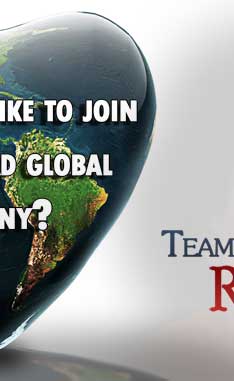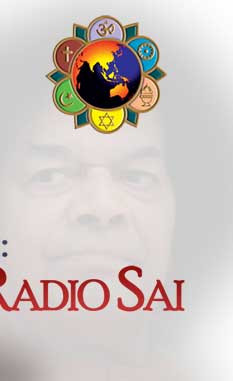Joining Hands with Team Radio Sai to
Spread His Message, Part-1
Musings by Prof. G. Venkataraman
 |
At the outset, I offer my humble pranams to our most beloved Bhagavan.
Loving Sai Ram and greetings from Prashanti Nilayam. Today, I intend to make good a promise I made in my previous talk namely, to toss an idea about how interested listeners who wish to become pro-active in spreading the Divine Message, can team up with us, etc. Those details would come later but by way of setting the stage, let me first offer you the following quote from one of Swami’s discourses.
Swami’s Salient Message for this Age
Actually, it is one of the Sai Inspires messages that go out every day, currently to over sixty thousand people. This is what Swami says in the quote:
Listen to the ‘Sai Inspires’ clip |
 |
|
There is a Divinity higher than humanity that is behind and underlying all human activities. However, humans are not aware of it and they fail to benefit by that awareness. Your first task therefore is to cognise this source of joy and peace. That Divinity is like the thread in which the flowers are strung; we see only the garland; we do not cognise the string that holds the flowers together and makes a garland out of a heap of blossoms. Mankind is strung together by this inherent Divinity. |
The reason I am referring to this quote is that seeing God everywhere is the key element of Swami’s teachings. Almost all of our work here flows from that. It therefore stands to reason that if listener groups wish to have a piece of our action, then they must first understand how we apply ourselves to spreading the message. All that might sound mysterious and fuzzy, and so let me first say a few words about the quote itself, so that you understand better what I shall be saying later.
These days, an alarmingly large number of people don’t believe in God, and a good many of those who do are hardly aware that God is omnipresent. On the other hand, in the above quote Swami is telling us loud and clear that He is in fact everywhere.
How Can God Be Everywhere?
People often protest, “How can you say God is everywhere? If that is so then I should be able to see Him; but I do not and hence I don’t buy this idea of omnipresence of God!” This is an old argument and a clever man who believed in God responded to his friend, a non-believer – let’s call him Mr. Smith – as follows: “Look here Mr. Smith, I cannot see your brain; am I to presume that you do not have one?”
A pretty witty repartee there, but serious debaters would dismiss such light-hearted arguments. A Vedantin would instead say: “God is everywhere, but He cannot be seen with our eyes because His presence is subtle. God’s presence around us can only be experienced and not seen because He is immanent. We cannot see air. On that basis, can we deny there is no air around us? Are there not experiments to prove the existence of air?”
 |
 |
 |
In the Gita, when Arjuna asked, “Krishna, how is God present in me?” Krishna gave a simple and beautiful reply. That explanation has been amplified below, drawing upon what Swami has said. As He has told us any number of times, every human being is a composite of three distinct entities, they being a) the gross body, b) the subtle Mind and c) the causal Atma. It is interesting to note in passing that these entities come as it were, from three different universes namely, gross, subtle and causal; however, we shall not get diverted in that direction. Instead, let us try to understand in some detail what Krishna said to Arjuna.
The body, as we are all aware, is made up of molecules which in turn are made up of atoms. All these come from the physical universe and in that sense, we can trace the ancestry of the gross body all the way to the Big Bang. Since the atom is inert, by itself the body also is inert, which is why the scriptures refer to it as jadam. And yet, even in inert matter there is the beauty and power of God. Is there power of God in inert matter? Well, think of a nuclear power station where electrical energy is generated by releasing the energy locked up in uranium atoms by fissioning them. Who thoughtfully put all that energy into the atom? As both Krishna and Swami remind us, it is God who locked that power into the atom. That is how the power of God is immanent in every single atom and molecule in the body. That also is why oxygen, carbon, calcium, etc., play their respective roles in the biochemistry of the body, in strict accordance with the rules of physics and chemistry. Those rules did not drop from heaven; nor were they laid down by our chemistry teacher. These Laws of Nature as we refer to them came directly from God the Creator.
Based on that explanation, I trust you would agree that God or the Atma, call it what you will, is indeed immanent in the gross body. Moving on, let us consider what happens when we eat food. Krishna says, “O Arjuna, you eat food; how do you think that food gets digested?” Today’s man would jump up and say: “I know! When the food reaches the stomach, juices are produced therein…..blah, blah, blah!” All that is factually correct but this kind of explanation misses the point by light years.
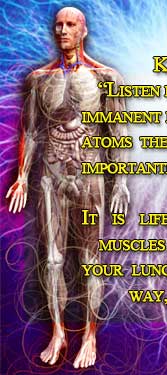 |
 |
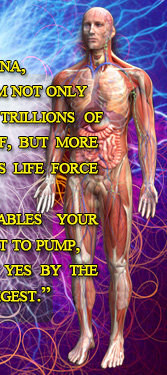 |
God Permeates Our Body as Praana Shakthi
You want to know why? Start first with this business of chewing and swallowing the food. Unless the muscles of the jaw, the throat, etc., do their job, the food is not going any place. But how does this jaw action etc., take place? All that happens thanks to the life force or Praana Shakti as it is called. Thus it is that Krishna said to Arjuna, “Listen my dear fellow, I am not only immanent in the trillions and trillions atoms of your body, but more importantly, also as the life force or Praana Shakti. It is this life force that enables your muscles to move, your heart to pump, your lungs to breathe, and yes by the way, your stomach to digest.”
By that way, that is the precise reason why Swami has included in our pre-meals prayer the sloka that starts with the words, “Aham Vaishwanarova….” etc. Let me slip in a few more quick points. They are a) Praana Shakti is subtle, b) it powers not only the lungs, heart, etc., but also the brain, and c) being subtle, it also supplies energy to that special gift of God that humans alone have, namely the Mind. That is why Krishna tells Arjuna, “Among the senses, I am the Mind!” Seen from this angle, it should be clear that death is a process where God switches off the Praana Shakti. The body immediately becomes a mere hunk of inert matter that people are then in a hurry to get rid off!
God = Atma
So far we have seen how God is immanent in our gross body as well as the subtle Mind. That leaves the Atmic aspect within us. Here there is no need for any further explanation since God is Atma and Atma is God. We thus see that God is in fact present in us at every possible level, the gross, the subtle and the causal. By the way, it is to remind us that the Atma is within us that in olden times, Swami used to begin His Discourses with the words, “Divyatmaswaroopalara,” or Embodiments of the Divine Atma. Later, He switched to, “Premaswaroopalara,” or Embodiments of Divine Love, to call special attention to the fact since God is Love and Love is God, we all ought to behave like God rather than bark like bulldogs which, sad to say, happens often.
The Macro form of God is Society
Lest you think I have got lost, let me place all of the above in the context of how I began this talk. Remember I wanted to call attention to the omnipresence of God. I then said, “Look, God is within us too, and in fact, at three different and distinct levels.” Since God is in all of us without exception, it follows that God is everywhere in the Cosmos, from quarks and leptons all the way to galaxies, clusters of galaxies, black holes, and what not. More important, He is in every single living being here on earth, including of course all humans, which automatically means that God is in Society also. In fact Swami goes to the extent of saying Society is God in macro form, whereas all of us are the micro form of God. Swami has given a nice analogy. He says the individual in Society is rather like the cell of the body, whereas Society as a whole is like the body as a total organic entity. Swami adds, “If you want Society to be healthy, then each and every one of you must function in precisely the same way individual cells function in the healthy body.”
 |
This exactly is where the problem arises. In brief, in the body every entity from the cells upward serves the body as a whole and takes good care of it. For its part, the body does all it can to nourish and sustain every single part itself via suitable exercises, food and rest. In a nutshell, there is selflessness everywhere along the chain, both upwards as well as downwards. Translate this to Society, and we get the following rules:
- Every single individual must serve Society selflessly, since Society is nothing but God.
- This implies that every single individual must see God in every other being, both humans and lower species as well.
OK we do all this, but what do we get in return? Unfortunately, this is the way we are trained to think nowadays! Fortunately, Swami has Himself given the answer. He says, “Bangaru (Golden One), if you do that, Society would take care of you, in fact in a thousand different ways!” If you think about it, Swami’s advice has a deep connection to the omnipresence of God, the topic I started with.
What Happens When We Disassociate God from Education?
Which brings me at last to my point: How do we go about seeing this omnipresence, serving Society, etc? This is a question with infinite ramifications and no one can answer it in its entirety. However, one can get a feel for what the answer implies by considering one aspect of Society, and that exactly is what I shall do now. More specifically, I shall spend the next few minutes discussing aspects of education, an area of social activity to which Swami has contributed immeasurably. We shall examine what happens to education if we fail to see God in fellow human beings and in society. Once that becomes clear, you would automatically see how Swami’s educational system shows the way to fixing the various problems.
Education is huge topic and I can hardly do justice to it in a talk like this. That, however, does not prevent me from referring to a few aspects, so that you can not only appreciate better the subtler aspects of Swami’s contribution but also think about what you there and we here could do together to spread Swami’s Message. Specifically, I wish to comment briefly on three aspects relating to education, all of recent origin. They are as follows:
- The rapid rise in cost of education, especially higher education.
- The skew in the employment pattern and its implications.
- The disconnect between education and values.
This is a limited agenda; yet it is enough to give a glimpse of how far-reaching Swami’s teachings are, since they, i.e., His teachings, impact all the points mentioned above.
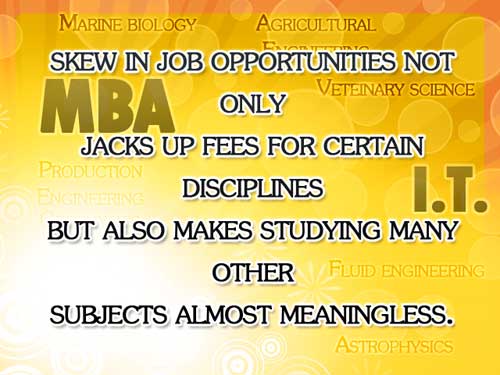 |
Let us start with the issue of increased cost of higher education, something that has happened in recent times. It all started in the post-war period when America galloped forward in manufacture, creating thereby almost insatiable demand for electrical, mechanical, chemical, and various other types of engineers. Since local production of such engineers could not satisfy market demand, American universities began to accept overseas students in large numbers. That also was when India established half a dozen Institutes of Technology, IIT’s as they were called, which were copies of hitech universities in America. Entry into IITs was very difficult; nevertheless, over the decades several thousands of students not only made it to these institutes, but also went from there to America to get advanced degrees, great jobs, good salaries and thereby become a part of middle-class America. After that came the MBA wave, followed by the IT boom. Thus the type of degrees that were favoured kept on changing, in step with market preferences.
Noting the large demand for engineers and the fact that State Universities could not meet this demand, the Indian government allowed the entry of the private sector into higher education. Particularly during the last decade or so, there has been a huge, mushroom growth all across India of engineering colleges, MBA schools, and institutes offering various courses related to IT, of course all for a very high fee. Did these colleges and universities have the requisite standards and quality? That is a different issue altogether. When private colleges and universities began to proliferate, they also began to draw away competent teachers in the traditional and established institutions. Of course this meant paying high salaries but private educational institutions took care of it by charging astronomical fees. In fact, they were run like business enterprises purely for making huge profits, which they did. So desperate were people to chase the new “upper middle-class dream”, that they were ready to pay anything to get into these dream factories. Soon the government was forced to raise salaries of teachers in their institutions, because they had to do something to retain their staff, all of which automatically increased the tax-payers burden.
Education Today Has Transformed Into a Lucrative Business
To cut the story short, from KG to PG as Swami often says, education has now become an incredibly expensive proposition – please note that here I am talking of India and not America. In fact, things have become so atrocious that kids at the age of two have to enrol in what are called pre-kindergarten schools so that they can easily get into KG and thereafter into primary schools, which is where formal education is supposed to commence. All this may sound funny to people who are well off, but if you think of say a taxi driver or a small farmer in a village, this is a nightmare. After all, they too want their kids to have a better future than themselves. The entry fees for such preschools of various kinds are astronomical, even in villages; and these are not schools but mere money- sucking engines.
 |
 |
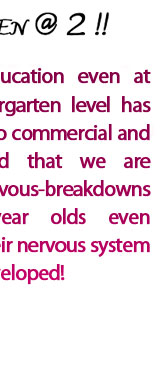 |
The consequences of all this are horrendous, especially for people in the lower-income bracket. Indeed even for fairly well-to-do upper middle class families in say a place like Delhi, it is a nightmare for parents to get their two-year olds into Pre-KG schools. They not only have to spend a lot of money getting coached for facing parent interviews, but also have to train their two-year old to face a gruelling admission test. I once heard a radio program on all this business in which a paediatrician came down heavily on how the market was literally destroying children in hundreds of thousands even before they had learnt to give their names properly. He lamented, “What are we trying to do? We are giving nervous breakdowns to two-year old kids even before their nervous system is fully developed!”
Dear listeners, all this is not even the tip of the iceberg. Nevertheless, the points I have made above ought to be clear. They are:
- Education in most countries has now become largely a for-profit industry.
- It is so even in a country like India.
- It is all due to extreme competition that makes everyone go through one narrow gate to the other side, which is supposed to be heaven but is not.
- This new, highly-restricted filter system places everyone under a huge stress, irrespective of status and age.
- Those who fail to get pass the gate, and they number in tens of millions, are assured a life of low standard where everything is a struggle, from food to water to shelter to jobs to medical assistance, etc.
Keep this in mind as we go to the next topic in the list I mentioned earlier. Remember also that in all this, the market always calls the shots. I now shift the focus from India to America, since the new trend has its origin there. People glorify the market but the latter is not immune from problems, headaches and stresses. Thus during the last 20 years or so, we have seen at the highest level, an interesting see-saw phenomenon.
Marketisation of Education: The Sad Story in American Society
To start with as industry prospered, getting an MBA degree became the in-thing and the royal path to fat salaries. In other words, the engineering degree one already had was not so valuable, unless it was topped off with a MBA degree. Then came the IT boom, which made a degree in computer science even more attractive than the MBA. So you see how market preferences keep changing. To get back to my main narrative, the IT boom was followed then by the dotcom bubble in America; this happened around the year 2000, I believe. This also was the period when the financial industry began to boom with its newly invented “financial derivatives” or FD’s as they were called. At this stage the focus shifted again, and the best thing was to go for a degree in maths followed by another in financial management. Finally came the great Wall Street crash in late 2008 that threw almost everyone out in the street, and overnight American economy suffered a huge collapse, dragging a large part of the world along with it.
 |
I think I have said enough to draw attention to what might be called the employment skew. Basically, thanks to market forces, demand arises for certain type of skills and almost zero demand for other types with, of course, preferences also changing rapidly. Since job opportunities seem to be concentrated in limited areas, institutions of higher education also tend to focus on related disciplines. In practical terms it means that fees for students wanting to qualify in those disciplines become astronomical.
For example, where medicine is concerned, radiology is one such discipline. It costs a lot of money to get a post-graduate degree in radiology, both in America and in India. In India, for example, it costs about one and half crore rupees just to get admission; the tuition, hostel, books etc., come later. For those of you who are not familiar with Indian currency, the admission fee known as capitation fee works out to about quarter of a million dollars, maybe a bit more, depending on the exchange rate. This is an astronomical amount in India and pretty high I guess even by US standards. In India, it is usually the parents who borrow to fund this kind of fees, while in America it is the student who borrows to get the degree he or she is after. From what I have heard, student loans are offered with great enthusiasm in America, but once students become trapped, life becomes extremely tough thereafter.
I do not wish to go into all that, but the point I wish to make is that skew in job opportunities not only jacks up fees for certain disciplines but also makes studying many other subjects almost meaningless. A market-oriented person may shrug it all off and say, “Well, that is the way the cookie crumbles. If we want the benefits of market economy, we have to pay the price.”
This brings me to the last of three points I mentioned earlier, which relates to the basic question: “What exactly is the role of education in society?” Until recently education, including higher education was expected to serve society in many different ways. The market guys would claim that service to market is service to society. That, however, totally ignores the basic fact that humans have a soul.
The Prime Minister Lauds the Holistic Approach of Sai University
To put it simply, if money and market alone are to determine the way society is to be shaped, then there is absolutely no place for art, literature and so many things that give meaning to life, making it something more than merely a luxurious life style. Interestingly, during the recent convocation of Sri Sathya Sai University, the Prime Minister of India Dr. Manmohan Singh sounded a warning about educationists totally losing sight of the importance of culture and the finer arts, while planning curricula. This is what he said:
 |
In the context of Swami’s University, this might be called preaching to the converted. However, since what the PM said was national news, his remarks were really addressed to entire country.
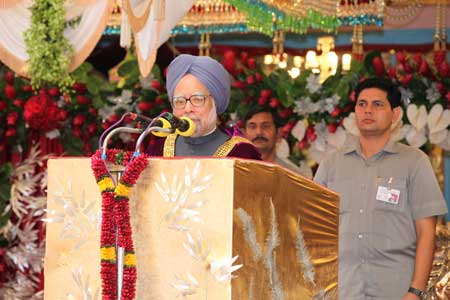 |
|
The Prime Minister of India Dr. Manmohan Singh giving the Convocation address to the University Students in Prashanti Nilayam on 22nd November 2010 |
Time is moving on and I do need to bring this talk to an end. But before I do so, let me return to the main reason why I am giving this talk. I am sure that at least some of you would be aware about what Swami has said regarding education. You would also be aware that the word educare is repeated endlessly in this context. However, since people hardly spend any time thinking about what exactly educare means, few understand its implications. I make this point because if people around the world had remained sensitive to values and recognised their importance to society as a whole, then many of the problems we face today would not have arisen in the first place.
In short, what it boils down to is that we need to revisit Swami’s teachings in depth and thereafter examine critically how they impact the individual as well as society in all possible manners. This is the general direction in which Radio Sai intends to go, intensively and with great emphasis, by way of serving humanity. In other words, we wish to highlight the relevance and importance of various aspects of Swami’s teachings vis-a-vis ALL aspects of modern life and society.
The Mission of Radio Sai – Share Sai’s Message of Pure Love
Years ago, Swami Himself used to do this via His discourses. The time has come for us to absorb those lessons, and explain TO AS MANY PEOPLE AS POSSIBLE their contents as well as implications in the context of prevailing situation, so that young people of today pay serious attention to them, make full use of them and ensure THEREBY the continuation of values in society.
This is clearly too big a task for us here to do it all by ourselves. That is why we are looking for partners with multiple talents. Don’t worry if you live far away from Prashanti. Distance is hardly an issue in this internet age; what is important are enthusiasm, determination and firm commitment.
Shortly, we would be publishing a manifesto, shall I say, outlining what we have in mind and how we would like to go about it. Please take a good look at it and respond to the special e-mail id given there. There are so many things to do and there are so many different ways in which you could contribute. Everyone has some hidden talent that can be made use of. The world is calling out for you, and all you have to say is: HERE WE COME!
Are you inclined? Are you game? Would you like to join our global team to spread global harmony? Then don’t miss seeing the bulletin just referred to; be on the lookout for it; watch this space, as they say!
|
I am running out of time and had better wind up. Before I do so, there are two things I would like to mention. Firstly, at the end of this talk you would hear a short audio clip, taken from a recent broadcast that originated from the radio service operated by Boston University in America. Please listen carefully to it, for it illustrates the point I have tried to make, namely, how education policies can and do affect society in many different ways. No doubt, this clip touches only one tiny corner of the huge spectrum of problems. At the same time, if you think about it, you would also realise that if society is guided by Swami’s teachings, then such problems would not arise in the first place. This point needs to be most emphatically and persuasively highlighted to the world at large, so that more and more people begin to understand what Swami’s Message really means and how we should not waste time any longer by merely paying superficial attention to it.
People talk of cutting the Gordian knot. The world today is bundled up in one huge super Gordian knot. The only scissor that can cut it is the Teachings of Swami.
I think I have said enough. Before I sign off, allow me to share with you a small piece of information. Last week, as I was walking out of the studio after recording my talk, our recording engineer Mr. Sunil Kumar, who has always been at the control desk whenever I do a recording told me that I had just completed my 199th talk. That would make this presentation my 200th talk over Radio Sai. Not bad, is it?! If I have managed to come this far, it is unquestionably due to Swami’s Grace, not forgetting of course, the tremendous support you listeners have always and most unfailingly, given me.
Thank you all, and God bless. May Radio Sai keep going endlessly, in future with strong global participation.
Offering this talk to Swami I end with the prayer:
Samashta lokha sukhino bhavantu
|
Dear Reader, did this article help you in anyway? Please share your feelings with us by writing to h2h@radiosai.org mentioning your name and country. Thank you for your time.



